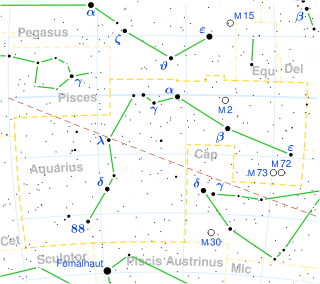Nu Aquarii
Nu Aquarii (ν Aqr, ν Aquarii) is the Bayer designation for a star in the equatorial constellation of Aquarius.
 | |
| Observation data Epoch J2000 Equinox J2000 | |
|---|---|
| Constellation | Aquarius |
| Right ascension | 21h 09m 35.64888s[1] |
| Declination | –11° 22′ 18.0851″[1] |
| Apparent magnitude (V) | 4.52[2] |
| Characteristics | |
| Spectral type | G8 III[3] |
| U−B color index | +0.66[2] |
| B−V color index | +0.94[2] |
| Astrometry | |
| Radial velocity (Rv) | –11.23[4] km/s |
| Proper motion (μ) | RA: +94.12[1] mas/yr Dec.: -14.62[1] mas/yr |
| Parallax (π) | 20.47 ± 0.21[1] mas |
| Distance | 159 ± 2 ly (48.9 ± 0.5 pc) |
| Absolute magnitude (MV) | +0.93[5] |
| Details | |
| Mass | 2.35[5] M☉ |
| Radius | 8[4] R☉ |
| Luminosity | 37[4] L☉ |
| Surface gravity (log g) | 2.8[4] cgs |
| Temperature | 4,920[4] K |
| Metallicity [Fe/H] | –0.15[4] dex |
| Rotational velocity (v sin i) | 0.0[4] km/s |
| Age | 708[5] Myr |
| Other designations | |
| Database references | |
| SIMBAD | data |
With an apparent visual magnitude of 4.52,[2] Nu Aquarii is visible to the naked eye. Its distance from Earth, as determined from parallax measurements, is around 159 light-years (49 parsecs). At an estimated age of 708 million years,[5] it has evolved into a giant star with a spectrum that matches a stellar classification of G8 III.[3] It has than double the mass of the Sun[5] and has expanded to eight[4] times the Sun's radius. Nu Aquarii is radiating 37-fold[4] the luminosity of the Sun from its outer atmosphere at an effective temperature of 4,920 K.[4] At this heat, the star is glowing with the yellowish hue of a G-type star.[7]
Together with μ Aquarii, it is Albulaan /ˌælbjəˈlɑːn/, a name derived from the Arabic term al-bulaʽān (ألبولعان), meaning "the two swallowers". This star, along with ε Aqr (Albali) and μ Aqr (Albulaan), were al Bulaʽ (البلع), the Swallower.[8][9]
In Chinese, 天壘城 (Tiān Lěi Chéng), meaning Celestial Ramparts, refers to an asterism consisting of ν Aquarii, ξ Aquarii, 46 Capricorni, 47 Capricorni, λ Capricorni, 50 Capricorni, 18 Aquarii, 29 Capricorni, 9 Aquarii, 8 Aquarii, 14 Aquarii, 17 Aquarii and 19 Aquarii.[10] Consequently, the Chinese name for ν Aquarii itself is 天壘城十 (Tiān Lěi Chéng shí, English: the Tenth Star of Celestial Ramparts.)[11]
References
- van Leeuwen, F. (November 2007), "Validation of the new Hipparcos reduction", Astronomy and Astrophysics, 474 (2): 653–664, arXiv:0708.1752, Bibcode:2007A&A...474..653V, doi:10.1051/0004-6361:20078357.
- Johnson, H. L.; et al. (1966), "UBVRIJKL photometry of the bright stars", Communications of the Lunar and Planetary Laboratory, 4 (99), Bibcode:1966CoLPL...4...99J.
- Buscombe, W. (1962), "Spectral classification of Southern fundamental stars", Mount Stromlo Observatory Mimeogram, 4, Bibcode:1962MtSOM...4....1B.
- Massarotti, Alessandro; et al. (January 2008), "Rotational and Radial Velocities for a Sample of 761 HIPPARCOS Giants and the Role of Binarity", The Astronomical Journal, 135 (1): 209–231, Bibcode:2008AJ....135..209M, doi:10.1088/0004-6256/135/1/209.
- Takeda, Yoichi; Sato, Bun'ei; Murata, Daisuke (August 2008), "Stellar parameters and elemental abundances of late-G giants", Publications of the Astronomical Society of Japan, 60 (4): 781–802, arXiv:0805.2434, Bibcode:2008PASJ...60..781T, doi:10.1093/pasj/60.4.781.
- "nu. Aqr". SIMBAD. Centre de données astronomiques de Strasbourg. Retrieved 2012-07-02.
- "The Colour of Stars", Australia Telescope, Outreach and Education, Commonwealth Scientific and Industrial Research Organisation, December 21, 2004, archived from the original on December 3, 2013, retrieved 2012-07-02.
- Davis Jr., G. A. (October 1944), "The Pronunciations, Derivations, and Meanings of a Selected List of Star Names", Popular Astronomy, 52 (3): 12, Bibcode:1944PA.....52....8D.
- Allen, R. H. (1963), Star Names: Their Lore and Meaning (Reprint ed.), New York: Dover Publications Inc, p. 53, ISBN 0-486-21079-0, retrieved 2010-12-12.
- (in Chinese) 中國星座神話, written by 陳久金. Published by 台灣書房出版有限公司, 2005, ISBN 978-986-7332-25-7.
- (in Chinese) AEEA (Activities of Exhibition and Education in Astronomy) 天文教育資訊網 2006 年 5 月 15 日